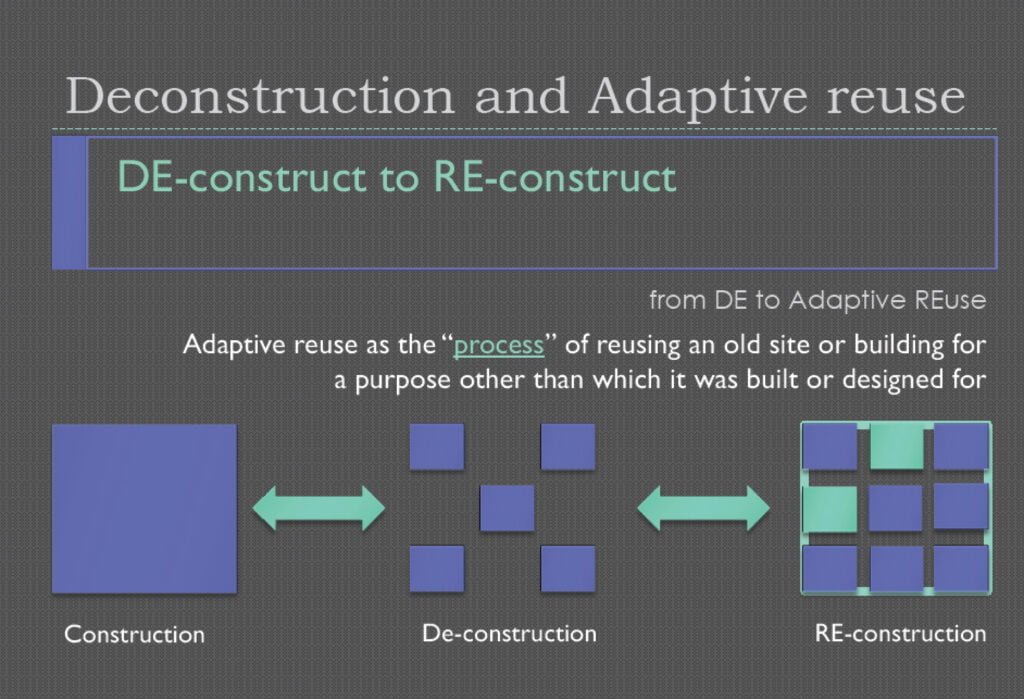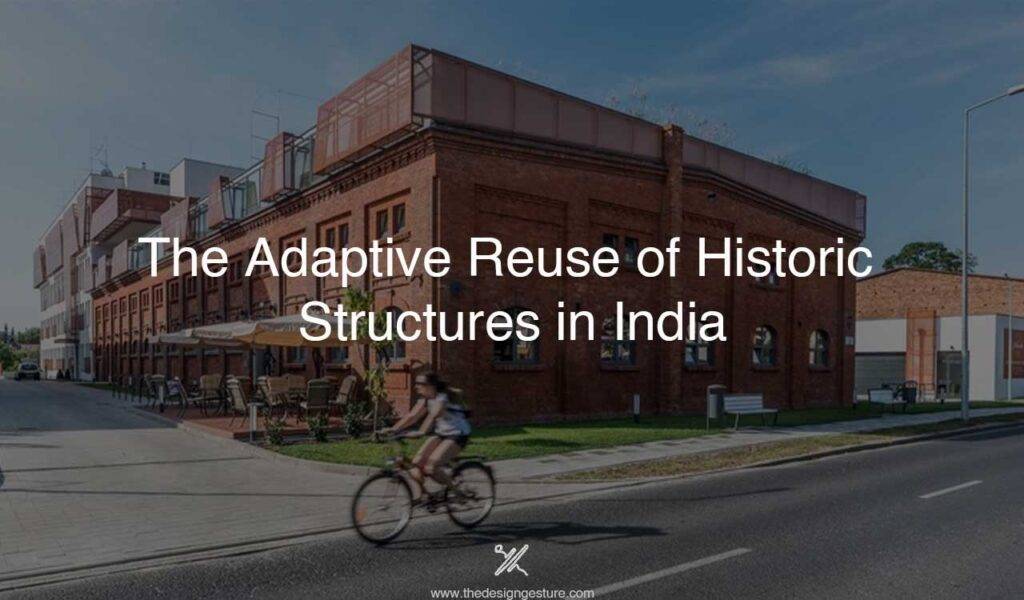Table of Contents
What is adaptive reuse?
The technique of reusing or adapting an existing structure for use other than its intended intent is known as the adaptive reuse of historic structures. The building may be used for a longer period thanks to repurposing. Even while various types of construction can be recycled, the phrase is usually used to refer to the reusing of old buildings. This will spare innumerable structures from being destroyed and rebuilt.
Our ancestors engaged in substantial adaptive reuse projects back when building supplies were scarce and shipping and construction were pricey. As industrialization progressed, it became much simpler and less expensive to purchase goods at lower prices and convey them via complex road networks. Widespread construction and unsustainable building techniques were the results. Adaptive reuse is frequently associated with historic structures, but it can also be used to breathe new life into vacant, neglected, or underused structures that are still in good condition.
According to Yang and Chan, “adaptive reuse is a new kind of maintainable rebirth of the city since it includes the lifetime of the building, saves demolition waste, encourages the recycling of embodied dynamism, and delivers significant social and economic benefits to the world. It has become an exciting and creative challenge for architects to work with historic buildings and repair and restore them for ongoing usage. Structure change is referred to as “adaptive reuse.”
Adaptive reuse is now viewed as a key tactic for protecting cultural assets in conservation theory and practice. A thorough review of academic writing on the subject from the 1970s to the present reveals that adaptive reuse theory is mostly founded in case study research, not architectural theory or/and conservation history, as one might expect.
This article will provide a critical study of adaptive reuse theories from the nineteenth and twentieth centuries. From the standpoint of reuse, these contrasting ideas addressed the formal architectural link between old and new for the first time, as well as the discussion around this relationship.
The importance of reusability
There are three conservation techniques, which are as follows:
1. The upkeep of structures (Preservation)
2. Reinstauration (Restoration)
3. Adaptive reuse
Each of these measures for conserving the environment cannot be applied uniformly to all types of buildings. When the natural resources were conserved, Numerous variables, including, influenced the selection of the optimal approach.
(I) The significance of historical significance of the construction
(ii) Cultural significance
(iii) Condition of one’s physical health
A building can only be preserved and restored if it has the potential to draw visitors as a tourist destination or if it can still serve the function for which it was originally built. The only method to conserve a building that doesn’t fit into one of these categories is to keep it in use, a practice known as an adaptive reuse.
One must adjust to the changing circumstances by making the necessary modifications for the building’s new use without reducing its inherent historic value to preserve an old building, even if the neighborhood is undergoing significant changes and the building’s original function is no longer applicable.
Examples of adaptive reuse techniques in India
The fight for Indian freedom has dominated the history of our nation. With independence came new laws, a new constitution, and a new form of government. Before we gained our independence, our country was split into 562 Princely States that had a say in how affairs were run and The British Province, which was fully administered by the British.
After the British colonialists left India on August 15, 1947, India and Pakistan became independent states. The Princely States faced a decision between remaining independent and allying with one of the two superpowers.
Any structure constructed by a former princely state ruler and acknowledged as such by the Central government is exempt from taxation under the Act. Prior monarchs, however, leased palaces and other buildings outside of their royal residences to the government for its use as a result of this statute. Currently, government organizations like courts and local authorities, as well as educational institutions, are housed in these buildings. Many buildings have served purposes different than that for which they were designed throughout history. Throughout the conflict, several buildings served as makeshift hospitals and camps.
Many abandoned factories and warehouses were converted into schools, hospitals, and even places of worship several decades following the industrial revolution, fusing the new with the old. Thus, it may be argued that “reuse” is not a novel idea in India. Whether you realize it or not, it has become a regular part of your life. A Haveli is frequently transformed into a business district. To do this, palaces must be converted into government buildings, mills into hotels, and residential streets into commercial districts.
There are three primary adaptive reuse options, each with its antecedents and ways for integrating the new use inside the current building. One of these is the possibility of preserving a structure for its original function.
This might result in a
1 modification of the purpose of the structure or
2 a modification to the building’s usage.
3 The facade of the building is remodeled, but the interior stays unaltered.

Considerations to be made in the adaptation
- No Cultural or heritage loss –
The adaptation shouldn’t considerably lessen the cultural significance of the original while maintaining the structural integrity and significance of the structures. It is best to make adjustments that are largely reversible or have little impact. No cultural heritage should be lost. We also need to have the ability to assess the intangible aspects of age, personality, and architectural excellence. It is crucial to take into account a structure’s original cultural importance while repurposing it.
Because its architectural legacy is unique due to this personality. Therefore, whether substantial or minor, any additions or alterations to a historic structure should not overpower its original character. Even if there appears to be a mismatch in the styles or materials, the building’s original design must be honored.
- Visual Significance –
With the area, Important connections between the structure and its site must be respected, preserved, and not violated. The environment must be compatible with any additions or adjustments. Even after renovations, a visitor should be able to tell that a building is from the area. The building should not look out of place with its surroundings.
The location is essential when deciding how many alterations or additions should be made to a building, especially a historical one.
- Compatibility with historic personality-
The character of the ancient town or urban area must be maintained while adding new functions and activities. If a building is to be used for something entirely different, the new use ought to complement both the building and its surroundings.
The degree of modification the structure can withstand and whether the community wants such a change would determine the building’s new function. For instance, a defunct mill in a district with a high concentration of businesses could be transformed into a shopping center or an office building. However, if it’s close to a residential area, it can end up becoming a public area. If it’s situated in a historically noteworthy area, it might be used as a museum or tourist attraction.
- Contemporary functional aspects-
The improvement of space should be furthered by the usage of contemporary components. Public services should be improved by new construction and upgrades. The integrity, personality, and shape of the structure should not be altered or added to.
Architectural features like the outside or interior shouldn’t be sacrificed if a structure is reused and new utilities like water, electricity and other modern amenities must be added. Shafts and ducts shouldn’t alter the existing features or draw attention to them. If escalators and elevators are required, they should be incorporated gradually through a series of interior changes rather than as an afterthought. Any façade updates should either enhance or blend in with the existing components.
- New dimensions, materials, and finishes-
The charm of the original should be preserved and enhanced while new volumes, materials, and finishes should represent contemporary ideas. The building’s intriguing characteristics, its historic contexts, its compositional balance, or its connection to its surroundings shouldn’t be diminished by additions. Modern additions might contribute to the improvement of space.
No matter how big the addition is, it shouldn’t overwhelm the old building that it’s built on. Three types of new finishes that are necessary for the building’s completion include the restoration of an old feature using the same or similar material, a finish that shows the influences of the old without copying it, and the use of new materials in a new style while also reflecting the old materials.
Conclusion
A very lengthy amount of time has passed in India’s history. Many of the original buildings there are now vacant and empty. The structures can be rearranged while maintaining their historical relevance and making the most of their practicality. The thoughtful and informed reuse of historic structures could help create a community that is conscious of its impact on the environment and works to maintain a healthy way of life. It is conceivable that it might have a beneficial impact on Indian architecture.




